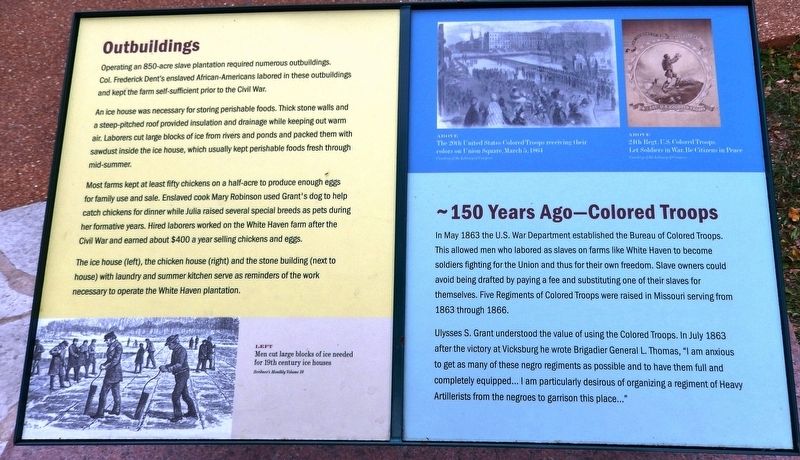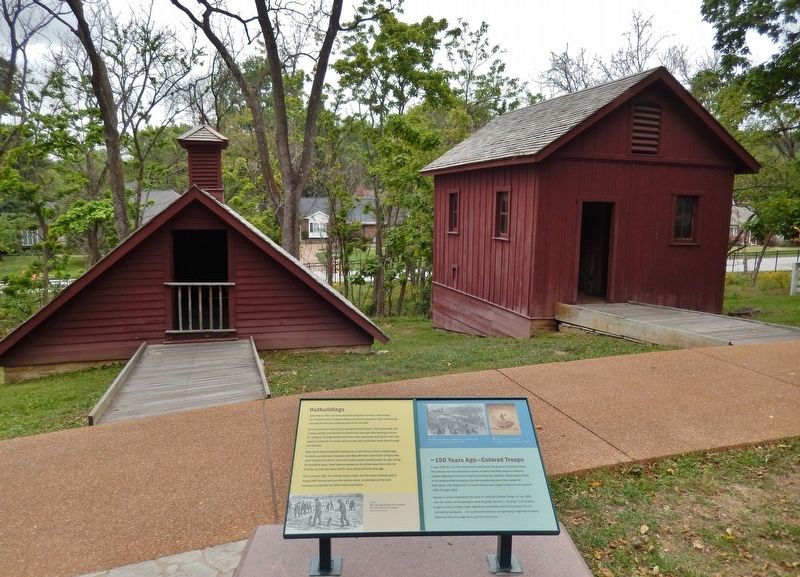Near Affton in St. Louis County, Missouri — The American Midwest (Upper Plains)
Outbuildings / ~150 Years Ago—Colored Troops
(left panel)
Outbuildings
Operating an 850-acre slave plantation required numerous outbuildings. Col. Frederick Dent's enslaved African-Americans labored in these outbuildings and kept the farm self-sufficient prior to the Civil War.
An ice house was necessary for storing perishable foods. Thick stone walls and a steep-pitched roof provided insulation and drainage while keeping out warm air. Laborers cut large blocks of ice from rivers and ponds and packed them with sawdust inside the ice house, which usually kept perishable foods fresh through mid-summer.
Most farms kept at least fifty chickens on a half-acre to produce enough eggs for family use and sale. Enslaved cook Mary Robinson used Grant's dog to help catch chickens for dinner while Julia raised several special breeds as pets during her formative years. Hired laborers worked on the White Haven farm after the Civil War and earned about $400 a year selling chickens and eggs.
The ice house (left), the chicken house (right) and the stone building (next to house) with laundry and summer kitchen serve as reminders of the work necessary to operate the White Haven plantation.
(right panel)
~150 Years Ago—Colored Troops
In May 1863 the U.S. War Department established the Bureau of Colored Troops. This allowed men who labored as slaves on farms like White Haven to become soldiers fighting for the Union and thus for their own freedom. Slave owners could avoid being drafted by paying a fee and substituting one of their slaves for themselves. Five Regiments of Colored Troops were raised in Missouri serving from 1863 through 1866.
Ulysses S. Grant understood the value of using the Colored Troops. In July 1863 after the victory at Vicksburg he wrote Brigadier General L. Thomas, “I am anxious to get as many of these negro regiments as possible and to have them full and completely equipped… I am particularly desirous of organizing a regiment of Heavy Artillerists from the negroes to garrison this place…”
Erected by Ulysses S. Grant National Historic Site.
Topics and series. This historical marker is listed in these topic lists: African Americans • War, US Civil. In addition, it is included in the Former U.S. Presidents: #18 Ulysses S. Grant series list. A significant historical month for this entry is May 1863.
Location. 38° 33.133′ N, 90° 21.109′ W. Marker is near Affton, Missouri, in St. Louis County. Marker can be reached from Grant Road, 0.4 miles north of Gravois Road (Missouri Route 30), on the right when traveling north. Marker is located
on the grounds of the Ulysses S. Grant National Historic Site, along the pathway west of the plantation house, overlooking the ice house and chicken house. Touch for map. Marker is at or near this postal address: 7400 Grant Road, Saint Louis MO 63123, United States of America. Touch for directions.
Other nearby markers. At least 8 other markers are within walking distance of this marker. Green Haven? (within shouting distance of this marker); A Community within a Community / ~150 Years Ago—Contraband (within shouting distance of this marker); Early Owners of the Farm (within shouting distance of this marker); New Buildings for White Haven (within shouting distance of this marker); Slaves Only (within shouting distance of this marker); The Roads to White Haven (within shouting distance of this marker); The White Haven Estate: Other Houses (within shouting distance of this marker); The Working Farm (within shouting distance of this marker). Touch for a list and map of all markers in Affton.
Also see . . .
1. War Department General Order 143: Creation of the U.S. Colored Troops (1863). News from Fort Sumter set off a rush by free black men to enlist in U.S. military units. They were turned away, however, because a Federal law dating from 1792 barred Negroes from bearing arms for the U.S. Army. The Lincoln administration wrestled with the idea of authorizing the recruitment of black troops, concerned that such a move would prompt the border states to secede. By mid-1862, however, the escalating number of former slaves (contrabands), the declining number of white volunteers, and the pressing personnel needs of the Union Army pushed the Government into reconsidering the ban. (Submitted on August 26, 2018, by Cosmos Mariner of Cape Canaveral, Florida.)
2. Bureau of Colored Troops. After the Emancipation Proclamation was announced, black recruitment was pursued in earnest. Volunteers from South Carolina, Tennessee, and Massachusetts filled the first authorized black regiments. However recruitment was slow until the support of prominent figures of African American cultures such as Frederick Douglass and Martin Delany. Martin Delany was commissioned as a major, the first African-American field officer in the United States Army during the American Civil War and was active in recruiting blacks for the United States Colored Troops. Frederick Douglass, on the other hand, encouraged black men to become soldiers to ensure eventual full citizenship. (Submitted on August 26, 2018, by Cosmos Mariner of Cape Canaveral, Florida.)
3. Ulysses S Grant Mational Historic Site. National Park Service (Submitted on August 27, 2018.)
Credits. This page was last revised on March 25, 2023. It was originally submitted on August 26, 2018, by Cosmos Mariner of Cape Canaveral, Florida. This page has been viewed 183 times since then and 18 times this year. Last updated on October 15, 2018, by Devry Becker Jones of Washington, District of Columbia. Photos: 1, 2. submitted on August 26, 2018, by Cosmos Mariner of Cape Canaveral, Florida. • Andrew Ruppenstein was the editor who published this page.

